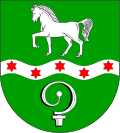| Municipality | Flag | Coat of arms | Enactment Date | Description | Ref. |
|---|
| Averlak |  |  | 25 May 1990 | A white flag with two blue stripes, a green stripe with a hill and two houses and two blue shovels. The flag alludes to the location of the municipality. The blue represents the North Sea, the Kiel Canal and Kudensee. Shovels and houses represents the importance of soil-based construction. Designed by Uwe Nagel. | [10] [11] |
| Barkenholm |  |  | 3 June 2002 | Banner of arms. Green represents the moorland, blue represents and yellow represents moraines. The seven bricks represents the seven brickyards. The wavy lines represents Broklandsau. The leaf is a common element of nature. | [12] |
| Bergewöhrden | | | TBA | No official flag or coat of arms. | |
| Brickeln |  | 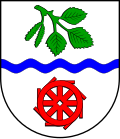 | 18 October 1995 | A white flag with two wavy blue stripes, two green leaves and a red wheel. Two green branches alludes to the name of the municipality. Two blue waves represents the creeks. The red wheel represents the former windmill. Designed by Uwe Nagel. | [13] [14] |
| Buchholz |  | 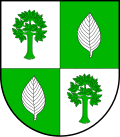 | 9 February 1989 | A green-white-green flag with two leaves symboling the forests and two trees representing wood. Together, they symbolized the red beeches that used to cover the municipality. The design alludes to the origin of the name of the municipality (Buchholz = beech wood). Designed by Uwe Nagel. | [15] [16] |
| Burg |  |  | 26 August 1952 | A blue-white-blue flag with the a red castle and two blue keys. The red castle represents the Bökelnburg, which gives the municipality its name. The keys represent Saint Peter which the local church is dedicated. Two blue stripes represents the Burger Au and the Kiel Canal. Designed by Wilhelm Horst Lippert. | [17] [18] |
| Büsum | | 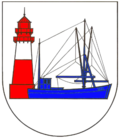 | 9 September 1991 | No official flag. The coat of arms features a red lighthouse and a blue krabbenkutter (a type of fishing boat). They both represent the North Sea and its dependence to sailors, fishers and tourists. | [19] [20] |
| Büsumer Deichhausen | | | TBA | No official flag or coat of arms. | |
| Dellstedt |  | 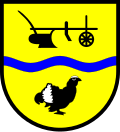 | 15 April 1988 | Blue flag with the coat of arms. | [21] |
| Delve |  | 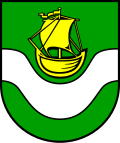 | Coat of arms:
8 May 1979
Flag:
11 September 1984 | Green-yellow-green flag with the coat of arms. Green represents the rural areas, yellow represents the Eider Canal and white represents the Eider river. Designed by Hans-Jürgen Böhrnsen. | [22] [23] |
| Diekhusen-Fahrstedt | | | TBA | No official flag or coat of arms. | |
| Dingen |  | 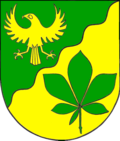 | 5 December 1990 | A green and yellow flag with five green and yellow stripes. Yellow represents the moraines and agriculture. The green represents the marshes and meadows. The wavy lines alludes to the Friedrichshöfer Au. The chestnut and goshawk represents Dinger Donn. Designed by Gerard Peter Parkinson. | [24] [25] |
| Dörpling | | | TBA | No official flag or coat of arms. | |
| Eddelak |  |  | 25 October 1993 | Banner of arms. The coronet represents Eddelak, which in turn represents the Virgin Mary. The windmill represents the economy of Behmhusen. Designed by Uwe Nagel. | [26] [27] |
| Eggstedt |  |  | Coat of arms:
26 September 1985
Flag:
20 April 1988 | Banner of arms. The harrow represents agriculture and the groves. Green represents pastures and farmers respectively. The corner, oak branches and the harrow alludes to the name of the municipality. Designed by Uwe Nagel. | [28] [29] |
| Fedderingen | | | | No official flag or coat of arms. | |
| Frestedt |  |  | 12 January 1993 | Banner of arms. The harrow represents agriculture and the groves. Green represents pastures and farmers respectively. The corner, oak branches and the harrow alludes to the name of the municipality. Designed by Uwe Nagel. | [30] [31] |
| Friedrichsgabekoog | | | TBA | No official flag or coat of arms. | |
| Friedrichskoog |  | 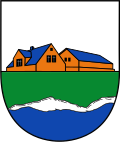 | 2011 (de facto) | A blue and white flag with the coat of arms. The coat of arms features depicts a farmhouse separated by a polder (which the municipality is named after) from the North Sea. | |
| Gaushorn | | | TBA | No official flag or coat of arms. | |
| Glüsing | | | TBA | No official flag or coat of arms. | |
| Großenrade |  | 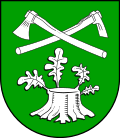 | Coat of arms:
11 January 1991
Flag:
16 March 1992 | Banner of arms. The axes and the cut down tree alludes to the name of the municipality. Green represents the woods that were cut down and nature. Designed by Uwe Nagel. | [32] [33] |
| Groven |  |  | Coat of arms:
12 November 1987
Flag:
12 November 1987 (de facto) | A horizontal blue-white-red flag (representing Schweig-Holstein) with the coat of arms. The coat of arms alludes to the municipality's name. The white waves represents storms. The horse and the fish represents herding and fishing respectively. Designed by Günter Brietzke. | [34] |
| Hedwigenkoog | | 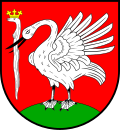 | 13 July 1938 | No official flag. The coat of arms is based on a local legend that during warfare, a stork (representing Hedwigenkoog) and a snake (representing Ahlen) turned into a swan and a snake respectively. Fancinated by the legend, Frederick IV named this kroog (municipality) after his wife, Hedwig Sophie upon completion of the kroog's construction. He gave this coat of arms to his wife. Designed by Gustav Adolf Cloß. | [35] [36] |
| Hellschen-Heringsand-Unterschaar | | | TBA | No official flag or coat of arms. | |
| Helse |  |  | Coat of arms:
18 September 1995
Flag:
23 April 1996 | A green-yellow-green flag with the coat of arms. The coat of arms features the windmill/fire wheel/water whirlpool sculpture by Paul Heinrich Gnekow (which is located in the municipality's sports centre) as a symbolism of dynamism and progress. The ring represents the Goldenen Ring polder built the 11th century and the sapphire on the ring symbolizes the North Sea. Designed by Hans Frieder Kühne. | [37] [38] |
| Hemme |  |  | Coat of arms:
26 January 1988
Flag:
27 September 1996 | A blue flag with nine blue and yellow stripes. The flag represents the local parish church. The crown is represents Mary being the Queen of Heaven. Roses and lilies are usually ossicated with the Virgin Mary for puritym love and justness. Designed by Günter Brietzke. | [39] |
| Hemmingstedt |  | 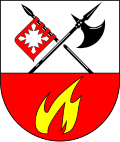 | 25 October 1988 | Banner of arms with eleven red and white stripes. This flag commemorates the battle of Hemmingstedt. The halberd represents the people of Dithmarschen while the lance represents Denmark. The flame represents oil. Designed by Hans Frieder Kühne. | [40] [41] |
| Hennstedt |  |  | 14 February 2005 | Banner of arms. Green represents marshes and yellow represents moraines. The white represents the Eider river. The embowed chief represents the hill that the municipality was built on. The wheel represents mobility and crafting. The spokes represents the places of the municipality. Willows are the trees usually seen in the municipality and its leaves represents clubs in the municipality. Green and yellow were the colours of the former Amt Hennstedt. Designed by Uwe Nagel. | [42] |
| Hillgroven | | | TBA | No official flag or coat of arms. | |
| Hochdonn |  |  | Coat of arms:
6 December 1991
Flag:
21 July 1992 | Banner of arms. Green represents agriculture. Green represents the woods that were cut down and nature. The railway bridge represents the Kiel Canal. The oak represents the Donn spit. Designed by Uwe Nagel. | [43] [44] |
| Hollingstedt | | | TBA | No official flag or coat of arms. | |
| Hövede | | | TBA | No official flag or coat of arms. | |
| Karolinenkoog |  |  | Coat of arms:
22 June 1984
Flag:
22 June 1984 (de facto) | Banner of arms. The crown represents Princess Wilhelmina Caroline of Denmark, who the municipality is named after. The ears of grain represents soil. Designed by Günter Brietzke. | [45] |
| Kuden |  | 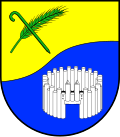 | 12 January 1995 | Banner of arms. Yellow represents moraines. Blue represents marshes. The oak represents the Donn spit. The white fort represents the Kuden Fort. A green ear of grain represents agriculture. The green stick represents the municipality's first citizen. Designed by Uwe Nagel. | [46] [47] |
| Norddeich |  |  | Coat of arms:
27 February 2003
Flag:
2 December 2014 | Banner of arms. The yellow rafter symbolizes the Goldener Ring dikes that allows farmers to harvest grain. The two white stars stands for the municipality's location and the Vogdemannen and the Beensman families (two of the municipality's well-known residents). The halberd is said to belonged to Ralves Karsten, who is a bailiff turned knight. He fought Hamburg from 1430 to 1434 while having his blood shed which represented by red. As a result of his courage through battle, he influenced the municipality and the surrounding areas. | [48] [49] |
| Oesterdeichstrich | | | TBA | No official flag or coat of arms. | |
| Oesterwurth | | | TBA | No official flag or coat of arms. | |
| Quickborn |  |  | 18 August 1993 | A green flag with nine green and white stripes. Yellow basin was said to be built around a well. Oak leaves represents the municipality's past as a forest. Designed by Uwe Nagel. | [50] [51] |
| Reinsbüttel |  |  | 30 October 2001 | Banner of arms. The blue and white wavy pattern represents the Wahrstrom strait (Büsum used to be an island until a dam was constructed in 1585–1609). The house displayed on the flag usually found on polders and represents the municipality's first inhabitants. The cart represents the hard work of farmers. Green represents marshes. Yellow represents the harvest season. Designed by Wilhelm Horst Otto Peiser. | [52] [53] |
| Sankt Michaelisdonn |  |  | 6 December 1991 | A blue flag with nine blue and yellow stripes. The farmer killing the dragon with a scythe represents the legend of Saint Michael. The vane represents the local windmill. Designed by Wilhelm Horst Lippert. | [54] [55] |
| Schülp |  |  | 17 May 2013 | No official flag. Designed by Renate Kainzberger. | [56] [57] |
| Strübbel | | | TBA | No official flag or coat of arms. | |
| Süderdeich | |  | 6 December 2004 | No official flag. The rafter symbolizes the 24 thatched roof houses in the municipality and their important roles, the wheel represents agriculture and the branch stands for nature. Designed by H. Schönknecht. | [58] [59] |
| Süderhastedt |  | 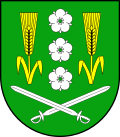 | 17 February 1993 | A green flag with nine white and green stripes. The swords alludes to the name of the municipality. Two ears of grains represent agriculture. Three roses represents the local church. Designed by Uwe Nagel. | [60] [61] |
| Warwerort |  | 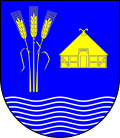 | 8 December 2014 | No official flag. Blue and eight white waves represent the North Sea and the former Warwerort port. The farmhouse and the three corn ears represent agriculture. Designed by Reimer Sievers. | [62] [63] |
| Wesselburen |  |  | Coat of arms:
22 February 1901
Flag:
15 July 2015 | Banner of arms. The bar and pallets represents the drainage trenches. The farmhouse represents those built on marshes. The municipality was developed during the Middle Ages through agriculture and the grain trade. In 1901, the king of Prussia granted the coat of arms to the municipality. Designed by Reinhold Boie. | [64] [65] |
| Wesselburener Deichhausen | | | TBA | No official flag or coat of arms. | |
| Wesselburenerkoog | | | TBA | No official flag or coat of arms. | |











